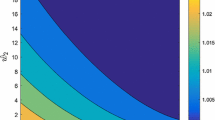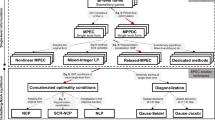Abstract
This paper investigates the ability of the largest producer in an electricity market to manipulate both the electricity and emission allowances markets to its advantage. A Stackelberg game to analyze this situation is constructed in which the largest firm plays the role of the leader, while the medium-sized firms are treated as Cournot followers with price-taking fringes that behave competitively in both markets. Since there is no explicit representation of the best-reply function for each follower, this Stackelberg game is formulated as a large-scale mathematical program with equilibrium constraints. The best-reply functions are implicitly represented by a set of nonlinear complementarity conditions. Analysis of the computed solution for the Pennsylvania–New Jersey–Maryland electricity market shows that the leader can gain substantial profits by withholding allowances and driving up NO x allowance costs for rival producers. The allowances price is higher than the corresponding price in the Nash–Cournot case, although the electricity prices are essentially the same.
Similar content being viewed by others
References
Anitescu M (2000) On solving mathematical programs with complementarity constraints as nonlinear programs, preprint ANL/MCS-P864-1200, Mathematics and Computer Science Division, Argonne National Laboratory, Argonne
Bushnell J. Mansur ET, Saravia C (2005) Vertical arrangements, market structure, and competition: an analysis of restructured U.S. electricity markets, WP-126, UCEI, University of California at Berkeley
Chen Y, Hobbs BF (2005) An oligopolistic power market model with tradable NO x permits. IEEE Trans Power Syst 20(1):119–129
Dirkse SP, Ferris MC (1995). The PATH solver: a non-Monotone stabilization scheme for mixed complementarity problems. Optim Methods Softw 5:123–156
Entriken R, Wan S (2003a) Agent-based simulation of an automatic mitigation procedure, EPRI Technical Report (Available at www.epriweb.com/public/000000000001007733.pdf)
Entriken R, Wan S (2003b) Pushing capacity payments forward: agent-based simulation of an available capacity market, EPRI Technical Report (Available at www.epriweb.com/public/000000000001007755.pdf)
Farrel AR, Carter R, Raufer R (1999) The NO x budget: market-based control of tropospheric ozone in the northeastern United States. Resource Energy Econ. 21(2):103–124
Ferris MC, Munson TS (2000) Complementarity problems in GAMS and the PATH Solver. J Econ Dyn Control 24:165–188
Fletcher R, Leyffer S (2002) Nonlinear programming without a penalty function. Math Program 91:239–270
Fletcher R, Leyffer S, Ralph D, Scholtes S (2002) Local convergence of SQP methods for mathematical programs with equilibrium constraints. University of Dundee Report NA\ 209
Fletcher R, Leyffer S (2004) Solving mathematical program with complementarity constraints as nonlinear Programs. Optim Methods Softw. 19(1):15–40
Fourer R, Gay D, Kernighan B (2003) AMPL: a modeling language for mathematical programming. Brooks/Cole–Thomson Learning. Wiley, California
Fudenberg D, Tirole J (1991) Game Theory. MIT Press, Cambridge
Gibbons R (1992) Game theory for applied economists. Princeton University Press, Princeton
Gill PE, Murray W, Saunders MA (2002) SNOPT: an SQP algorithm for Large–Scale constrained optimization. SIAM J optim 12(4):979–1006
Green RJ (1999) The electricity contract market in England and Wales. J Indus Econ. 47(1): 107–124
Hobbs BF (2001) Linear complementarity models of Nash–Cournot competition in bilateral and POOLCO power markets. IEEE Trans Power Systems. 16(2):194–202
Hobbs BF, Metzler CB, Pang J-S (2000) Strategic gaming analysis for electric power systems: an MPEC approach. IEEE Trans Power Syst. 15(2):638–645
Hobbs BF, Rothkopf MH, Hyde LC, O’Neill RP (2000) Evaluation of a Truthful Revelation auction in the context of energy markets with nonconcave benefits. J Regulatory Econ. 18(1):5–23
Hu X, Ralph D, Ralph EK, Bardsley P, Ferris MC (2004) Electricity generation with looped transmission networks: bidding to an ISO. Judge Institute of Management, Cambridge University, Research Paper No.2004/16
Kolstad JT, Wolak FA (2003) Using environmental emission permit prices to raise electricity prices; Evidence from the California electricity market. power Con. University California Energy Institute
Leyffer S (2003a) Complementarity constraints as nonlinear equations: theory and numerical experiences, Preprint ANL/MCS-P1054-0603, Mathematics and Computer Science Division, Argonne National Laboratory, Argonne
Leyffer S (2003b) Mathematical programs with complementarity constraints. SIAG Optim Views News. 14(1):15–18
Luo Z-Q, Pang J-S, Ralph D (1997) Mathematical programs with equilibrium constraints. Cambridge University Press, Cambridge
Mansur ET (2001) Pricing behavior in the initial summer of the restructured PJM wholesale electricity market, POWER Working Paper PWP-083, UCEI. University of California at Berkeley
Mansur ET (2003) Vertical integration in restructured electricity markets: measuring market efficiency and firm conduct, CSEMPW-117, UCEI. University of California at Berkeley
Metzler C, Hobbs BF, Pang J-S (2003) Nash–Cournot equilibria in power markets. on a linearized DC network with arbitrage: formulations and properties. Netw Spatial Theory. 3:123–150
PJM Market Monitoring Unit, (2001) PJM interconnection state of report
Newell RG, Stavins RN (2003) Cost heterogeneity and the potential savings from market-based policies. J Regulatory Econ. 23(1):43–59
Pepermans G, Willems B (2005) Ramsey pricing in a congested network with market power in eneration: a numerical illustration for Belgium, CSEM Working Paper WP-145, UCEI. University of California at Berkeley
Stavins RN (1995) Transaction costs and tradable permits. J Environ Econ and Manage. 19(2):133–148
Sartzetakis ES (1997) Raising rival’s costs strategies vis emission permits Markets. Rev Indus Organ. 12(5–6):751–765
Scheel H, Scholtes S (2000) Mathematical program with complementarity constraints: stationarity, optimality and sensitivity. Math Opera Res. 25:1–22
Schweppe FC, Caramanis MC, Tabors RD, Bohn RE (1988) Spot pricing of electricity. kluwer, dordrecht
Shanbhag UV, Glynn PW, Infanger G (2004) On the solution of stochastic equilibrium problems in electric power networks. In: Forty-Second Annual Allerton conference on communication, control and computing. September
Titetenberg T (2003) Environmental and natural resource economics, 6 edn. Addison Wesley, Reading
Tirole J (1998) The Theory of Industrial organization. MIT Press, Cambridge
Viscusi WK, Vernon JM, Harrington Jr JE (1995) Economics of regulation and antitrust, 2nd edn. MIT Press, Cambridge
Wolf DD, Smeers Y (1997) A stochastic version of a Stackelberg-Nash-Cournot Equilibrium Model. Manag Sci. 43(2):190–197
Yao J, Willems B, Oren S, Adler I (2005) Cournot Equilibrium in price-capped two-settlement electricity markets. In: Proceeding of the 38th Hawaii International Conference on Systems Sciences HICSS38. Big Island, Hawaii, January 3–6
Author information
Authors and Affiliations
Corresponding author
Additional information
We are grateful to two anonymous referees for their insightful comments that helped us improve the paper. This work is partially supported by NSF grants CS 0080577 and 0224817, by USEPA STAR grant R82873101-0, and by the Mathematical, Information, and Computational Sciences Division subprogram of the Office of Advanced Scientific Computing Research, Office of Science, U.S. Department of Energy, under Contract W-31-109-Eng-38. Any opinions or errors are the responsibility of the authors and not the sponsoring agencies.
Rights and permissions
About this article
Cite this article
Chen, Y., Hobbs, B.F., Leyffer, S. et al. Leader-Follower Equilibria for Electric Power and NO x Allowances Markets. CMS 3, 307–330 (2006). https://doi.org/10.1007/s10287-006-0020-1
Published:
Issue Date:
DOI: https://doi.org/10.1007/s10287-006-0020-1
Keywords
- Mathematical programs with equilibrium constraints (MPEC)
- Game theory (Stackelberg game)
- Economic market modelling
- Optimization algorithm
- Electric power




